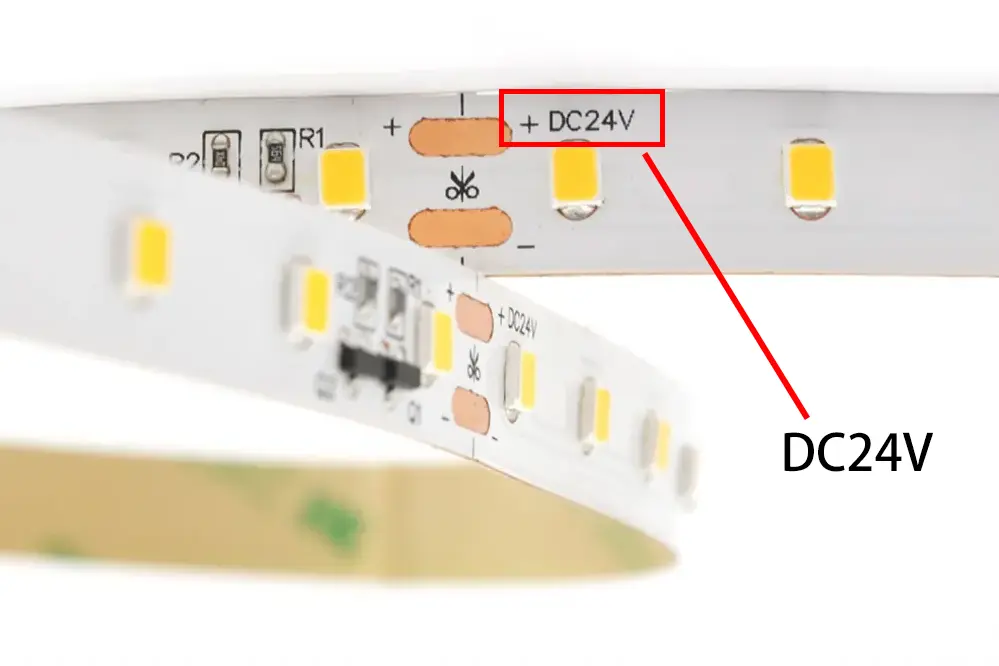Voltage is fundamental to LED strip lighting operations.
Understanding the appropriate voltage for LED strip lights is crucial, as mismatched voltage can result in inadequate illumination or potential damage to the lighting system.
When selecting LED strip lights, one typically encounters two common voltage options: ‘low voltage’—predominantly 12V or 24V—and ‘line voltage’ which can range up to 120V or 240V depending on geographic location and application purpose.
Choose wisely for optimal performance.
Understanding LED Voltage Essentials
The principle of voltage in LED strip lighting is akin to the lifeblood within an electrical ecosystem—it is the force that propels the photons to emanate from their semiconductor diodes. The specific voltage requirement of an LED strip is innately tied to its design and operational parameters, determining how the aforementioned electrical current is harnessed to optimize luminosity and longevity. A precise comprehension of voltage input is thus indispensable, guiding the proper selection and installation of LED strip lights, to ensure they function at peak efficiency within their intended environment.
Voltage Defined
Voltage is the driving force within an electrical circuit, a measure of potential energy that energizes electrons, propelling them through a conductor. It essentially dictates the flow rate of the electrical current within any given system.
It is essential to recognize voltage as a determinant of power consumption and the resultant light output. Operating an LED strip at its designated voltage maximizes efficiency, minimizes heat production, and prolongs lifespan significantly.
Lower voltage LED strips often exhibit enhanced safety due to decreased electrocution risks.
Understanding voltage is fundamental: when powering an LED strip, applying the incorrect voltage can lead to suboptimal performance (dimmer light or color distortion), premature failure, or even irreversible damage. Thus, a meticulous approach to voltage compliance is vital for ensuring reliable and consistent lighting results.
Importance for LED Performance
Voltage stability is paramount in maintaining the luminous efficacy of LED strip lights.
Since LED strips function within a narrow voltage range, deviations can manifest in light output instability, compromising visual performance. Exceeding the optimal voltage threshold, even marginally, triggers a heat increase, accelerating LED failure rates drastically.
Conversely, under-voltage conditions undermine LED brightness and color correctness, simultaneously straining the circuitry. This undue burden can precipitate erratic operation or an untimely end to LED functionality.
Adhering to the prescribed voltage ensures that energy is utilized judiciously, contributing to LED longevity and sustainability. Compliance with the specific voltage ratings is critical for the preservation of the LED strip’s color rendering index (CRI), a pivotal metric for color fidelity.
Optimal voltage application is a safeguard that maintains the integrity and performance consistency of LED strip lighting investments.
Common Voltages for LED Strips
In the realm of LED strip lighting, common voltages are predominantly 12V and 24V, tailored to suit various application needs and installation environments. The 12V LED strips are widely appreciated for their compatibility with smaller, residential applications, where power sources are readily available without the need for complex voltage transformation. On the other end of the spectrum, 24V LED strips are esteemed for their reduced current draw which allows for longer continuous runs with minimal voltage drop—ideal for commercial and large-scale installations. Understanding the voltage requirements is crucial for achieving optimal performance and longevity of the illumination system.
12V LED Strips
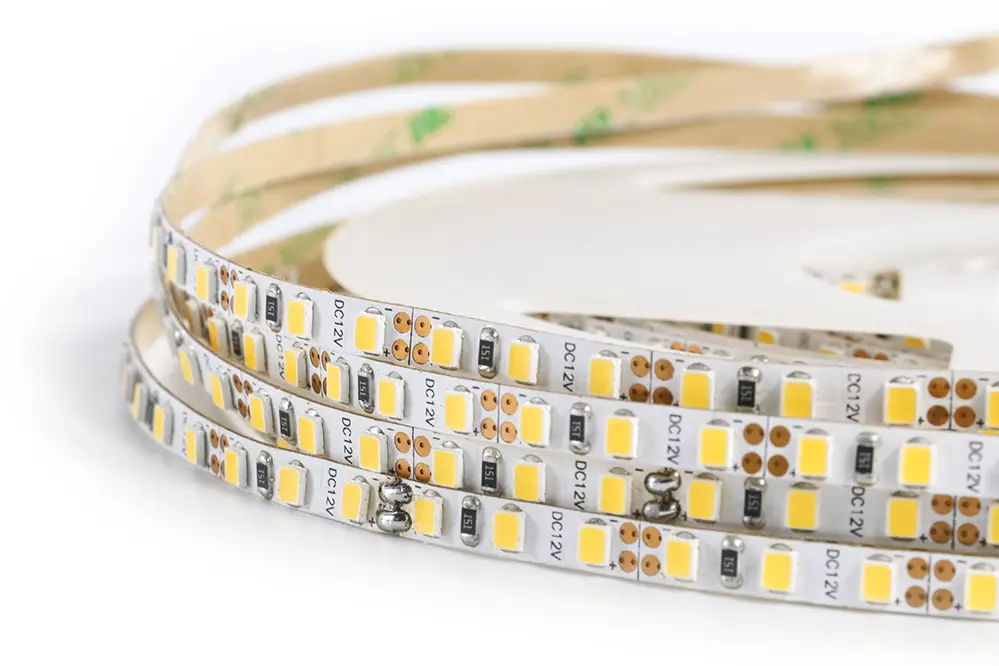
The ubiquity of 12V LED strips is noteworthy.
Their prevalence stems from several advantageous characteristics. Primarily, the lower operating voltage of 12V LED strips allows for a simpler and more secure installation process, minimizing the risks associated with higher voltages. Moreover, the compatibility of 12V systems with various off-the-shelf adapters and controllers makes them a convenient choice for DIY enthusiasts. However, the inherently lower voltage leads to a higher current requirement for the same power output when compared to their 24V counterparts, which can result in more evident voltage drop across extended lengths.
Voltage drop is a particularly salient concern.
Integrating a 12V power supply, or PSU, allows these strips to operate safely within their designed electrical parameters. By doing so, the installer ensures adherence to electrical codes and prevents the potential for overheating—a fundamental consideration for maintaining system reliability.
And remember, length influences voltage drop.
The technical implications of a 12V configuration extend to the importance of careful planning in the context of installation. Adjustable power supply units specifically designed for LED applications can provide the requisite stability, ensuring that luminance and color consistency remain unaffected over the length of the strip.
Preserving peak performance requires a dexterous approach.
As we embrace an age of increasingly sophisticated lighting solutions, it is paramount that the power supply adheres to the relevant standards and efficiency ratings—particularly with the forthcoming 2023 legislation targeting improved energy efficiency. Compliance with these standards involves using certified power sources and consulting professional advice when installing systems to guarantee the preservation of light quality and the utmost safety standards in our built environment.
24V LED Strips
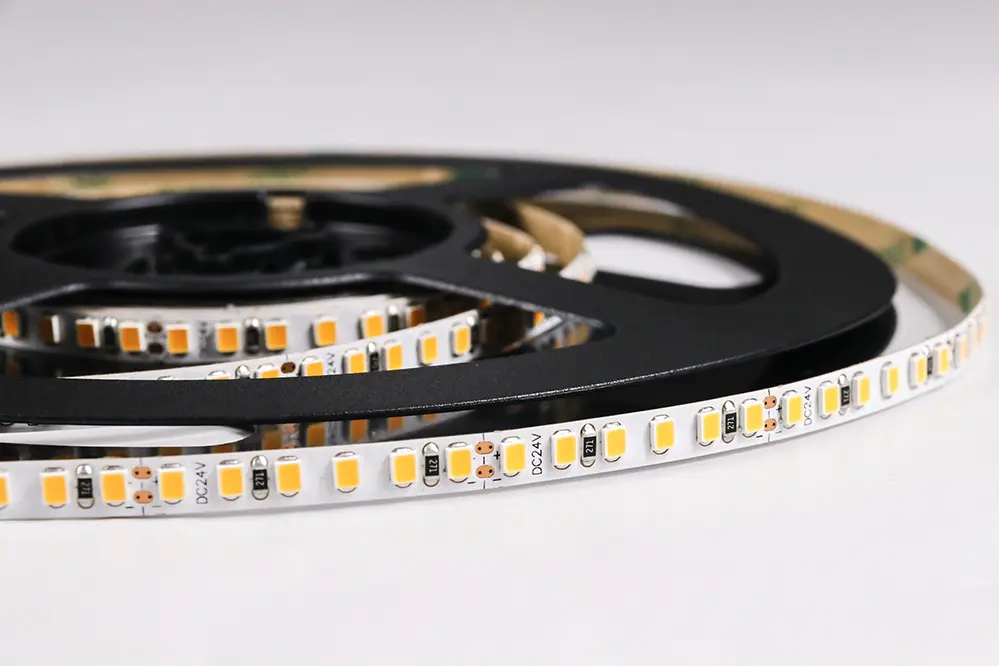
24V LED strips exemplify a standard in efficiency and versatility.
In comparison to their 12V counterparts, 24V LED strip lights offer enhanced capabilities for longer run lengths without significant voltage drop. This is of paramount importance in applications where uniform luminance across extensive installations is critical. Lower voltage drop equates to consistent brightness and color along the entire length of the strip, reducing the need for multiple power supplies and complex installation techniques.
Furthermore, the internal resistance of 24V strips is inherently lower, which leads to less power loss and enhanced energy efficiency. Such characteristics make 24V LED strips a preferred choice for a variety of lighting applications, from residential accent lighting to large-scale commercial projects. They also lend themselves well to situations that necessitate significant lengths of LED strip lighting with minimal additional wiring complexity.
The versatility of 24V LED strips makes them integral to modern lighting design. When deployed correctly, they can create expansive, evenly-lit surfaces with substantial cost savings over time. By utilizing fewer power supplies and boasting a higher tolerance to current fluctuations, 24V LED strip lights can offer a markedly improved life span. This reliability is matched by their adaptability, allowing for dimming and integration within smart lighting systems, providing a comprehensive solution for sophisticated lighting designs.
5V LED Strips
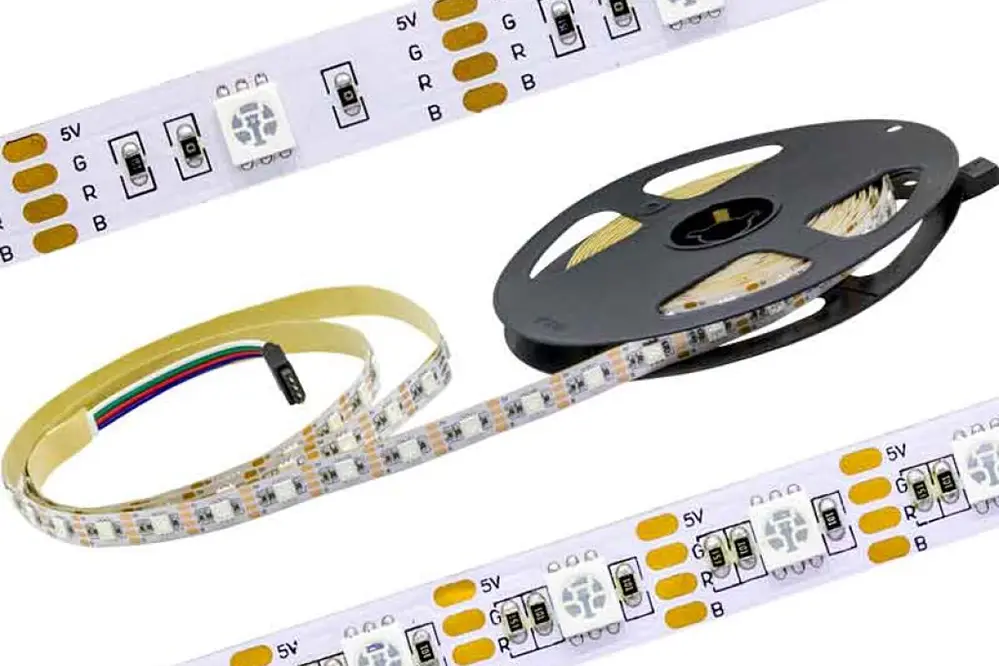
5V LED strips exemplify portability and convenience in the realm of LED lighting solutions. Their low voltage requirement makes them ideal for smaller, USB-powered applications, where compactness and ease of use are paramount. Notably, these strips are typically utilized in builds that necessitate subtle accentuation or where power sources are limited.
In the DIY and hobbyist sectors, 5V LED strips have garnered substantial popularity, due to their compatibility with computers, power banks, and even devices with USB ports. Their energy requirement aligns perfectly with the output of these devices, laying the groundwork for a plethora of innovative and personal lighting projects, from computer case lighting to portable, decorative installations.
Moreover, 5V strips are acknowledged for their utmost safety, given their low operational voltage that minimizes risks of electrical shock. This characteristic also allows for a broader user base, including those with limited electrical experience, to confidently incorporate LED lighting into their endeavors. They are also favored in prototyping or experimental projects that require a safe, low-voltage environment.
One must not misconstrue the low voltage of 5V strips as a limitation in brightness or color rendering. These strips can still embody a brilliant lumen output and a rich color spectrum, utilizing high-efficiency LEDs. Further, many 5V strips come with adhesive backing and are often flexible, promoting a convenient, tool-free installation process.
In conclusion, the 5V LED strip is a quintessential component in the panorama of personal and mobile LED lighting applications. Its minimal power draw, ease of use, and safety features make it a key player in the growing field of adaptable and user-oriented lighting solutions.
Alternating Voltages
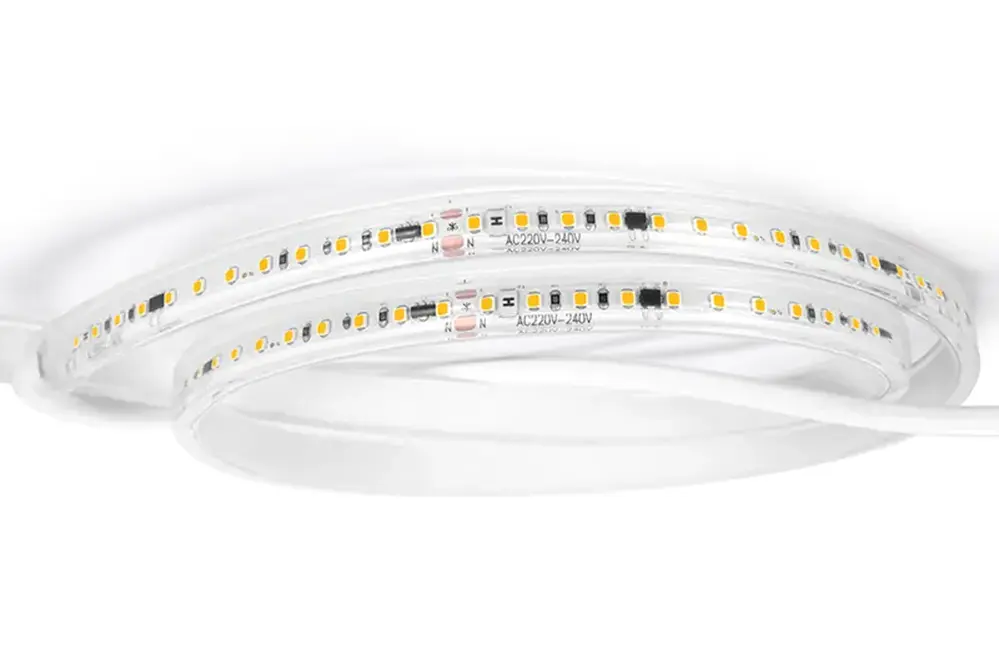
Alternating current (AC) voltages play an essential role in powering LED strip lights for large-scale applications.
- 110V AC – Commonly used in North America, suitable for long LED strips to prevent voltage drop.
- 220V/230V AC – Standard in Europe and other parts of the world, offering efficient energy conversion for LED lighting.
- 240V AC – Seen in regions like Australia, provides robust power for extensive and demanding installations.
These voltages necessitate the use of an AC to DC converter to ensure compatibility with LED technology.
LED strip lights designed for AC incorporate rectifiers, allowing them to operate efficiently on these higher voltages.
Matching Voltage with LED Projects

Understanding voltage requirements is critical for the successful implementation of LED strip lighting systems. The feasibility of a project hinges on accurately matching the voltage of the LED strips with the available power supply. This ensures optimal performance and avoids potential hazards or premature failure of the lighting elements. It is paramount for professionals to ascertain the voltage compatibility between the power source and the LED strips, especially when dealing with intricate installations. A meticulous approach to voltage selection underpins both the longevity and the aesthetic excellence of the project, safeguarding the installation’s integrity in a diverse array of settings.
Voltage Requirements for Length
When assessing the voltage needs for LED strip lights, one must account for voltage drop over extended lengths.
For extended runs, it is advisable to use higher voltages such as 24V or even 48V. This is because lower voltage strips, like 12V options, may experience significant voltage drop over distance. Frequent voltage drop can lead to inconsistent brightness and can even affect color consistency along the strip. Utilizing higher voltage LED strips mitigates these issues and ensures uniform illumination throughout the entire length.
Conversely, shorter LED strip sections thrive on lower voltages. In more compact configurations, where strip lengths are minimal, a 12V supply can be just as effective. Short runs are less susceptible to the pitfalls of voltage drop, therefore allowing for the use of a lower voltage without compromising on light quality or strip performance.
For those planning longer installations, it’s crucial to consider voltage when selecting your LED strips. Ensuring that the strips are capable of carrying the voltage across their entire length prevents dimming and color shifting that can occur with elongated runs. Thorough planning ensures not just the functionality but also the aesthetic appeal of your lighting installation, maintaining consistent brightness and color throughout, and guaranteeing a professional finish.
Power Supplies and Controllers
Proper selection of power supplies and controllers is essential for optimal LED strip light performance. A well-suited power supply ensures your LED strip receives the necessary voltage, preventing potential overdriving or underpowering that could shorten its lifespan. Precision is paramount when determining the appropriate power supply for your particular LED lighting configuration.
Select a power supply that matches your LED strip’s voltage requirement. It must provide adequate power without exceeding the strip’s maximum capacity, which can lead to overheating and failure. Balance is therefore key in the selection process.
Moreover, power supplies must accommodate the total wattage of your LED strip. Calculate this by multiplying the strip’s wattage per foot (or meter) by its total length. This will ascertain the power supply’s minimum wattage requirement.
Controllers are integral for managing the behavior and output of LED strips. These devices allow users to adjust brightness, change colors, and initiate dynamic lighting effects. Controllers must be compatible with the power supply and LED strip voltage to function correctly.
Choosing the correct type of controller is imperative, especially when dealing with dimmable or color-changing LEDs. Utilize a controller that supports the specific functionalities you require, ensuring seamless integration with your LED lighting system and the anticipated control over the lighting effects.
Lastly, proper connectivity between the strip, power supply, and controller is critical. Secure and correct wiring is essential for safety and functionality, preventing mishaps and ensuring the lighting operates as intended. Professional installation is often recommended to achieve this precision.
Safeguarding LED Longevity
Ensuring the longevity of LED strip lights hinges on adhering to voltage and current specifications prescribed by manufacturers. Exceeding these parameters can dramatically reduce the lifespan of LEDs, due to overheating and excessive current passing through the diodes. Thus, it is critical to match the LED strip with a power supply that delivers the correct voltage, without deviating from these guidelines as improper voltage can lead to premature failure of the LEDs.
In addition to selecting the appropriate power supply, voltage regulators and current limiters play a significant role in maintaining optimal operating conditions. Overvoltage conditions, which may occur during power surges, need to be mitigated to protect the sensitive electronic components within the LED strips. Precision-engineered voltage regulators maintain a stable output, while current limiters ensure that the amount of current flowing through the LED circuitry does not exceed safe levels, preventing overheating and potential damage.
Voltage Fluctuation Impacts
Unstable voltage supply can lead to inconsistent LED brightness and color. Sudden spikes or drops in voltage destabilize the electrical current, directly impacting the light output and color rendering of LED strips.
Over time, such fluctuations can cause premature aging of electronic components, manifesting as a decrease in luminous efficacy and potential discoloration of emitted light. High voltage surges can overstress the LEDs, resulting in irreparable damage, while under-voltage conditions lead to insufficient brightness and incomplete activation of the LED’s potential. This wear and tear on the diodes gradually erodes their performance integrity.
Continuously exposing LED strips to voltage instability can shorten their expected lifespan. Without proper voltage regulation, the delicate semiconductor materials undergo stress, which causes a phenomenon known as “electromigration.” This deterioration leads to an inevitable failure of the LED chips and associated driving electronics, necessitating early replacement.
For professionals overseeing LED installations, vigilance in mitigating voltage fluctuations is paramount. By implementing appropriate safeguards, such as surge protectors and conditioning power supplies, the stability and longevity of LED lighting systems can be maintained. Diligent monitoring of the electrical environment ensures that LEDs operate within their safe voltage ranges, thus preserving efficiency and luminance over time.
Tips for Voltage Stabilization
In selecting a power supply, match its output voltage precisely to the LED strip’s voltage requirement to prevent fluctuation-related issues, ensuring operational stability and longevity.
Voltage drop across long runs of LED strips should be addressed with strategic wiring techniques or voltage repeaters to maintain brightness consistency.
When designing the distribution of power, consider utilizing a centralized power source capable of sustaining steady voltage over multiple strips, rather than disparate supplies that might individually fluctuate and cause uneven illumination across the installation.
Ensuring your LED strip installation is equipped with voltage regulators and stabilizers can greatly reduce the risks of over-voltage occurrences that may induce stress on electronic components, which, in turn, could lead to the degeneration of the LED chips and shortened lifespan. Regulators actively maintain a consistent output within the safe operating parameters, significantly bolstering the reliability and performance of the lighting system.
FAQs
How does voltage affect LED strip lighting?
Voltage plays a crucial role in how LED strip lighting performs. LED strips require a specific voltage range to operate optimally and efficiently.
A higher voltage than the recommended range can cause the LED strip to overheat, which may lead to a shortened lifespan and reduced brightness. On the other hand, a lower voltage can result in a dim and flickering light output, affecting the overall performance and functionality of the LED strip.
To ensure the longevity and proper functioning of LED strip lighting, it is essential to adhere to the specified voltage range recommended by the manufacturer. This information can typically be found in the product’s specifications or user manual.
In cases where the voltage supplied by the power source does not match the required voltage of the LED strip, a voltage converter or power supply may be necessary. This device helps regulate and adjust the incoming voltage to ensure compatibility with the LED strip.
In summary, maintaining the correct voltage is vital for the optimal performance and longevity of LED strip lighting. By using the recommended voltage range and appropriate voltage conversion devices when necessary, you can ensure that your LED strip lighting operates at its best.
Do different color temperature LED strips require different voltages?
No, the color temperature of LED strips doesn’t affect the voltage they require. The voltage depends on the design and power requirements of the strip, rather than its color temperature.
Does the length of an LED strip affect the required voltage?
The length of the strip doesn’t alter the voltage requirement, but it can lead to voltage drop issues in longer strips. Employing amplifiers or running parallel power feeds can help mitigate voltage drop over extended lengths to sustain uniform brightness.
How do I know if my LED strip is 12V or 24V?
Determining the voltage of your LED strip is important to ensure compatibility with your electrical system. There are a few ways to figure out if your LED strip operates at 12V or 24V.
First, check the packaging or product specifications that came with your LED strip. Manufacturers usually provide information about the voltage requirement of their products. Look for labels such as “12V” or “24V” to confirm the voltage.
If you can’t find the information on the packaging or specifications, you can inspect the strip itself. Look closely at the strip and check for any markings or labels that indicate the voltage. The manufacturer may have marked the voltage directly on the strip, or there may be a designated area on the strip’s surface that specifies the voltage.
Another method is to examine the power supply or driver that is connected to the LED strip. The power supply should indicate the output voltage, which should match the voltage requirement of the LED strip. If the power supply is labeled as 12V, then your LED strip is also likely to be 12V. Similarly, if the power supply is labeled as 24V, then your LED strip will most likely operate at 24V.
Remember, it’s important to determine the correct voltage for your LED strip to ensure proper operation and to avoid any damage to the strip or your electrical system. If you’re unsure or can’t find the information, it’s always best to consult with a lighting professional or the manufacturer for clarification.
p.s.: You can read the article on How to check LED strip voltage.
Can you mix different voltages on one strip? Can I connect a 12V and 24V LED strip light together in the same circuit?
When it comes to mixing different voltages on one strip, the answer is a resounding no. It is absolutely not recommended to mix different voltages on the same strip.
Mixing different voltages on one strip can result in serious electrical hazards and potentially damage the strip or connected devices. Each strip is designed to operate at a specific voltage, and mixing voltages can cause a variety of issues including overheating, short circuits, and even fires.
Furthermore, mixing voltages can also lead to inconsistent and unpredictable lighting effects. Different voltages may result in variations in brightness, color accuracy, and overall performance of the strip. This can be particularly problematic in professional lighting setups that require precise control and uniformity.
To ensure the safety and optimal performance of your lighting setup, it is essential to use strips with matching voltages. Always consult the manufacturer’s specifications and guidelines to determine the compatible voltage for your strip. Additionally, it is advisable to seek the assistance of a qualified lighting professional for any installation or configuration involving multiple voltages.
What happens if the wrong voltage is used?
When the wrong voltage is used, it can lead to various negative consequences. The first paragraph will explain the immediate effects, followed by the long-term effects in the second paragraph. The third paragraph will explore the potential damage to electrical devices, while the fourth paragraph will discuss the risks of electric shock. Lastly, the fifth paragraph will emphasize the importance of using the correct voltage.
Using the wrong voltage can result in immediate issues such as power failure, flickering lights, or blown fuses. It can cause the electrical system to become unstable, leading to malfunctions or even fires within the building. Therefore, it is crucial to ensure that the correct voltage is supplied to prevent these hazards.
In the long run, using the wrong voltage can significantly reduce the lifespan of electrical equipment. Electrical components may heat up excessively, causing them to degrade and fail prematurely. This can result in increased maintenance costs and the need for frequent replacements of damaged devices.
The wrong voltage can cause severe damage to electrical appliances and devices. Overvoltage can lead to overheating, melting of insulation, and even the destruction of sensitive electronic components. On the other hand, undervoltage can cause devices to underperform or fail to function altogether. Using the correct voltage is essential to protect your valuable equipment from such damage.
One of the most significant risks of using the wrong voltage is the danger of electric shock. Higher voltages can increase the severity of electric shocks, putting individuals at a higher risk of injury or even death. It is crucial to follow electrical safety guidelines and only use the appropriate voltage for your specific devices to mitigate this risk.
In conclusion, it is imperative to ensure that the correct voltage is used to avoid the negative consequences associated with using the wrong voltage. This includes immediate issues like power failures and flickering lights, as well as long-term effects like reduced equipment lifespan. Additionally, using the wrong voltage can cause severe damage to electrical devices and increase the risk of electric shock. Always prioritize safety by using the appropriate voltage for your electrical systems.
Can LED strips be used with batteries?
LED strips can indeed be used with batteries. This is one of the advantages of LED technology, as it requires low power consumption.
By connecting the positive and negative terminals of the battery to the corresponding terminals on the LED strip, you can power it up and enjoy its illumination without the need for a direct electrical outlet. This makes LED strips a versatile lighting option for various applications, including areas where access to electricity might be limited.
It is important to consider the voltage and capacity of the battery when connecting it to an LED strip. Make sure the voltage of the battery matches the operating voltage of the LED strip to avoid potential damage. Additionally, taking into account the capacity of the battery is crucial to determine the running time of the LED strip before the battery needs to be recharged or replaced.
Keep in mind that the brightness and performance of the LED strip may vary depending on the battery’s characteristics. Choosing high-quality batteries with sufficient capacity will ensure optimal performance and longevity of the LED strip.
In conclusion, LED strips can be effectively used with batteries, providing a portable lighting solution for a wide range of situations. Careful consideration of the battery’s voltage and capacity will ensure proper functioning and longevity of the LED strip.
Conclusion
In summary, understanding voltage requirements is vital for LED strip light applications.
Matching LED strip lights to the appropriate voltage is a cornerstone of both safety and functionality. A proper understanding of voltage requirements not only prevents potential hazards but also ensures the longevity and reliability of the lighting system. Employing correct voltage aligns with the technical specifications of the LED strips, which is necessary to achieve optimal performance and luminosity. Any variations can compromise the entire setup, leading to inefficiencies or operational failings.
Furthermore, voltage has a pivotal role in the scalability of LED installations. By adequately addressing voltage needs, scalability and expansion become both feasible and efficient, unlocking the full potential of LED lighting solutions. This capacity to scale is essential for creating expansive lighting designs that maintain consistent brightness and performance throughout.
The intricacies of LED strip lights’ voltage requirements underscore the necessity for rigorous assessment and adherence to specified electrical standards. For enthusiasts and professionals alike, the knowledge of voltage intricacies serves as a beacon guiding towards a well-illuminated, effective, and safe lighting project. Future advancements will further refine these demands, propelling the LED lighting industry forward with innovations that enhance the balance between technical efficiency and the aesthetics of illumination.
In conclusion, when it comes to choosing the right voltage for your LED strip lights, it is important to consider your specific needs and requirements. While most LED strips from Unitop are currently available in DC24V, we also offer options for 12V and 230V, as well as other voltages. As a professional China supplier of LED strip lights and LED neon strips, Unitop is dedicated to providing high-quality products and exceptional customer service. Whether you are a lighting enthusiast or a professional in the industry, Unitop warmly welcomes OEM orders. For all your LED strip light needs, don’t hesitate to contact Unitop and benefit from their expertise and wide range of options.
